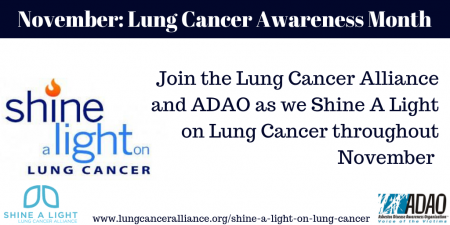Posted on October 31, 2018
The impact lung cancer has on our world can be difficult to comprehend. As the most common form of cancer on the planet, its size can stymie the mind. The sheer number of people it kills is at times, bewildering. November is Lung Cancer Awareness Month, and the time is now, to seek out an understanding of this vast and entirely-preventable disease.
At 1.8 million deaths worldwide, lung cancer kills more people than any other form of cancer. It is responsible for roughly 1 of every 6 cancer deaths on the planet. Of the 9.6 million total deaths attributed to cancer every year, 18.4% of them are linked to lung cancer.

This disease looms equally large in the U.S. It kills almost two times more Americans than colon cancer and nearly four times more than breast cancer. Even if we total all American deaths from prostate cancer (29,430), Leukemia (24,370), pancreatic cancer (44,330), liver cancer (30,200), bladder cancer (17,240), and thyroid cancer (2,060) – all of which the American Cancer Society considers among the most common forms of this disease – they don’t outpace our domestic mortality figures for lung cancer (154,050).
It is imperative, then, that we take this month to pause, reflect, and learn. ADAO is proud to observe Lung Cancer Awareness Month in our ongoing efforts to raise necessary awareness about two major asbestos-linked diseases: lung cancer and Mesothelioma.
Asbestos-linked lung cancer rates are increasing. Rapidly.
It was estimated that 10,000 American lives were claimed by asbestos-linked lung cancer. Strikingly, that rate has more than tripled in 2018, as the latest figures estimate more than 34,000 people will die from lung cancer as a result of asbestos exposure.
Know the difference between lung cancer and Mesothelioma.
While it is also a form of cancer, Mesothelioma is often misdiagnosed as a lung cancer. The difference is a subtle one: while mesothelioma often develops in the lining of the abdomen, heart, or the lung — lung cancer develops inside the lung itself. These diseases have much in common and they both can occur as a result of exposure to asbestos.
Second-hand asbestos exposure: the “deadly hug.”
There exists today an expansive and prominent discussion surrounding second-hand cigarette smoke. This is vital, and ADAO celebrates the extent to which the public has been educated about the dangers of tobacco.
From the lens of lung cancer prevention, however, we must also look to another tragic source of this disease: second-hand exposure to asbestos. We owe this to the aforementioned 34,000 Americans who will die from asbestos-linked diseases.
Perhaps surprisingly, many of these people had no direct connection to asbestos at all. They were not exposed while upending decades-old tiling, nor while fighting fires in pre-1980s homes, nor while repairing the brakes of an old car.
In fact, they were exposed when they hugged their mothers. Or when they washed their husband’s work clothes. Or perhaps when they simply shook their neighbor’s hand.
Second-hand asbestos exposure can ripple through a community at rapid rates. The fibers of this mineral cling to the clothing and hair of people who work directly with it, making exposure possible for countless others.
Get involved. Shine a light.
Each year, the Lung Cancer Alliance (LCA) organizes “Shine a Light on Lung Cancer” events around the nation. Hosted by healthcare facilities during the month of November, these events bring together those living with lung cancer, their families and the healthcare teams at hospitals across the country.
Help us Shine a Light on Lung Cancer by joining an event in your area, or even hosting a Shine a Light event yourself!
Together, change is possible.
Linda Reinstein
